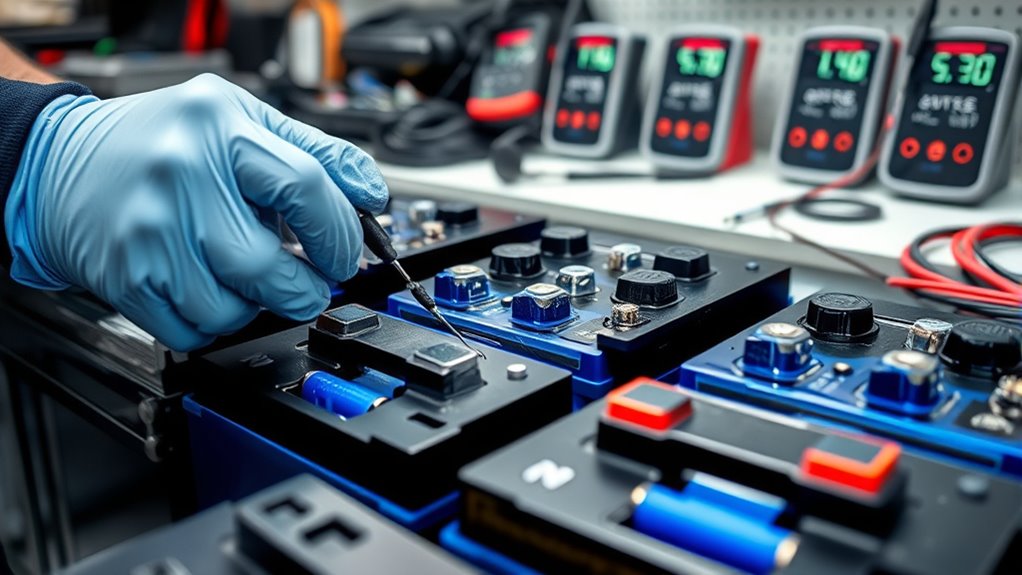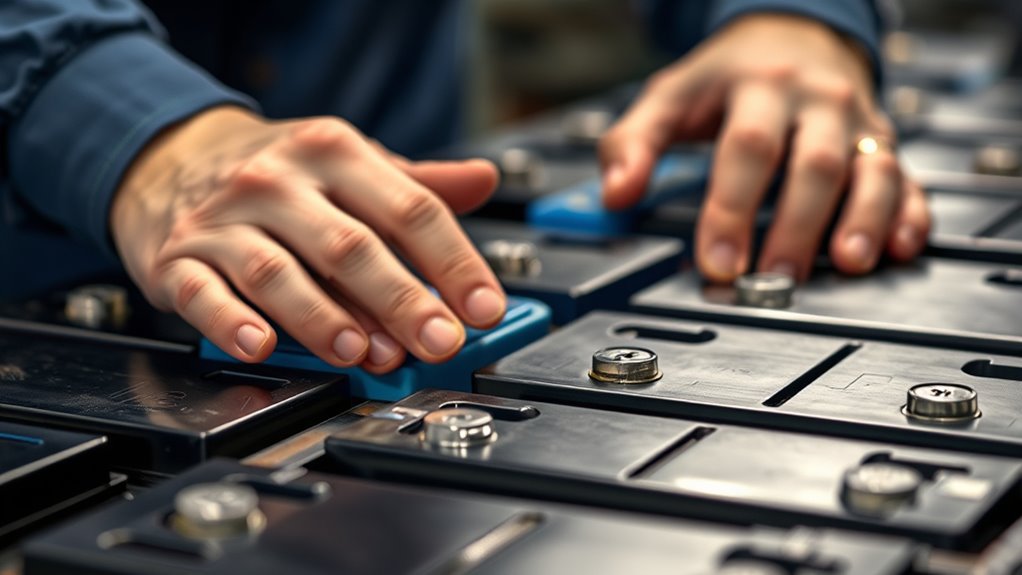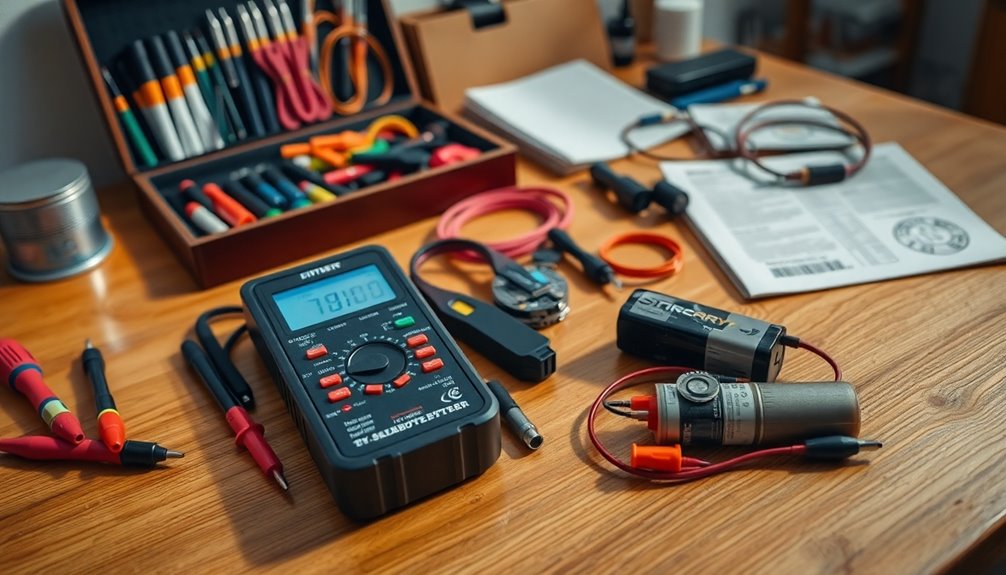When reconditioning AGM and gel batteries, it’s vital to understand their unique chemistries. AGM batteries use fiberglass mats soaked in acid, while gel batteries contain silica-based electrolytes that solidify into gel form. Both need special handling, safety gear, and proper disconnection procedures to prevent damage or injury. Knowing these differences helps you choose the right method and avoid common mistakes—if you keep going, you’ll discover more essential tips for safe, effective reconditioning.
Key Takeaways
- Understand the chemical differences: AGM batteries use soaked fiberglass mats, while Gel batteries contain silica-based gel electrolytes.
- Use appropriate reconditioning techniques tailored to each chemistry to prevent damage and ensure safety.
- Always wear protective gear and work in well-ventilated areas to handle corrosive acids safely.
- Properly disconnect batteries with insulated tools before starting reconditioning to avoid shorts.
- Consult manufacturer guidelines or professionals for specific procedures related to AGM and Gel battery reconditioning.

Are your AGM or Gel batteries losing their charge faster than they used to? If so, you might be considering reconditioning them to extend their lifespan. Before diving into the process, it’s essential to understand the unique battery chemistry of AGM (Absorbent Glass Mat) and Gel batteries. Unlike traditional flooded lead-acid batteries, AGM and Gel types utilize different electrolyte compositions that influence how they respond to reconditioning techniques. AGM batteries contain a fiberglass mat soaked in acid, allowing for better vibration resistance and faster charging, while Gel batteries use silica-based electrolyte that solidifies into a gel, making them more resistant to spillage and extreme temperatures. Recognizing these differences is crucial because it affects how you approach reconditioning and what safety precautions you must observe.
When reconditioning AGM and Gel batteries, safety should be your top priority. These batteries contain sulfuric acid, which is highly corrosive, and improper handling can cause serious injuries. Always wear protective gear, including gloves and safety goggles, to shield your skin and eyes from acid splashes. Work in a well-ventilated area to avoid inhaling fumes, especially if you’re performing procedures that involve opening or venting the batteries. Make sure you have the proper tools on hand, such as insulated screwdrivers and a multimeter, to prevent accidental sparks or shorts. It’s also vital to disconnect the batteries properly, avoiding any contact with metal tools that could cause a short circuit. If you’re unsure about any step, consult the manufacturer’s guidelines or seek advice from a professional to prevent damaging the battery or risking injury. Additionally, understanding the battery chemistry is key to applying the correct reconditioning method, as different types require distinct approaches for safe and effective results.
Frequently Asked Questions
Can Reconditioning Extend the Lifespan of AGM and Gel Batteries Indefinitely?
Reconditioning can extend the lifespan of AGM and Gel batteries, but it can’t make them last forever. Your success depends on understanding their battery chemistry and applying proper charging techniques. Regular maintenance and reconditioning can help prevent capacity loss and sulfation. However, eventually, all batteries wear out due to natural aging. So, while you can prolong their life profoundly, indefinite longevity isn’t possible.
Are There Specific Safety Precautions for Reconditioning These Types of Batteries?
Yes, there are specific safety precautions you should take when reconditioning AGM and Gel batteries. Always prioritize battery safety by wearing protective gear like gloves and goggles, and work in a well-ventilated area to avoid chemical hazards. Handle batteries carefully to prevent leaks or spills, and ensure proper disposal of any waste. These steps help protect you from potential chemical hazards and guarantee safe reconditioning practices.
What Are the Signs Indicating a Battery Is Suitable for Reconditioning?
Think of your battery as a patient showing signs of life. You’ll notice reduced performance, frequent voltage fluctuations, or persistent battery corrosion. If the voltage drops below the recommended level or corrosion appears on terminals, it’s a sign the battery might be reconditioned. These symptoms suggest the battery still has potential, but you should assess its overall health carefully before proceeding with reconditioning.
How Do Temperature Variations Affect the Reconditioning Process?
Temperature variations can considerably impact the reconditioning process. You should maintain temperature stability to prevent thermal cycling, which can cause internal damage to AGM and gel batteries. Fluctuations lead to uneven expansion and contraction, reducing battery lifespan. Keeping the environment consistent ensures safe, effective reconditioning. Avoid exposing batteries to extreme heat or cold during the process, as this can hinder recovery and compromise overall battery health.
Is Professional Reconditioning Preferable Over DIY Methods for AGM and Gel Batteries?
Picture yourself handling delicate glassware—precision and care matter. When reconditioning AGM and Gel batteries, professional expertise is preferable over DIY methods because it guarantees safety and effectiveness. DIY safety risks include incorrect procedures or hazardous materials. Professionals have the right tools and experience to prevent damage or accidents, maximizing battery lifespan. Trusting experts gives you peace of mind, knowing your batteries are reconditioned properly without risking personal safety or battery integrity.
Conclusion
By understanding the unique needs of AGM and gel batteries, you can give them a new lease on life. Just remember, you’re better off safe than sorry—don’t push beyond their limits or rush the process. Proper reconditioning can save you money and extend your batteries’ lifespan, but patience and attention are key. Keep these special considerations in mind, and you’ll avoid barking up the wrong tree, ensuring your batteries stay reliable for longer.










